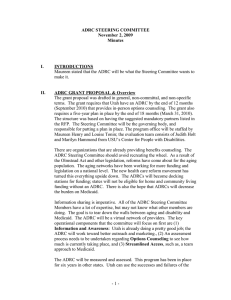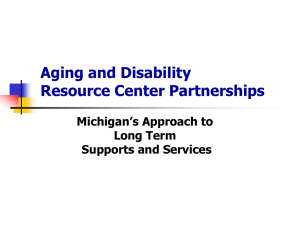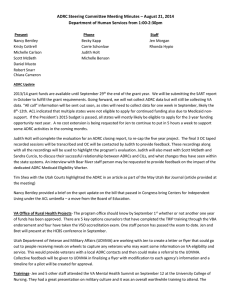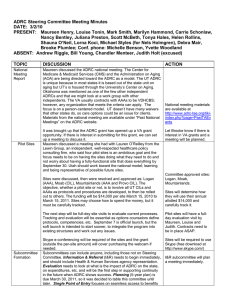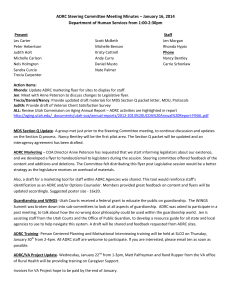Fully Functioning ADRC Awareness and Information outreach and marketing plan
advertisement
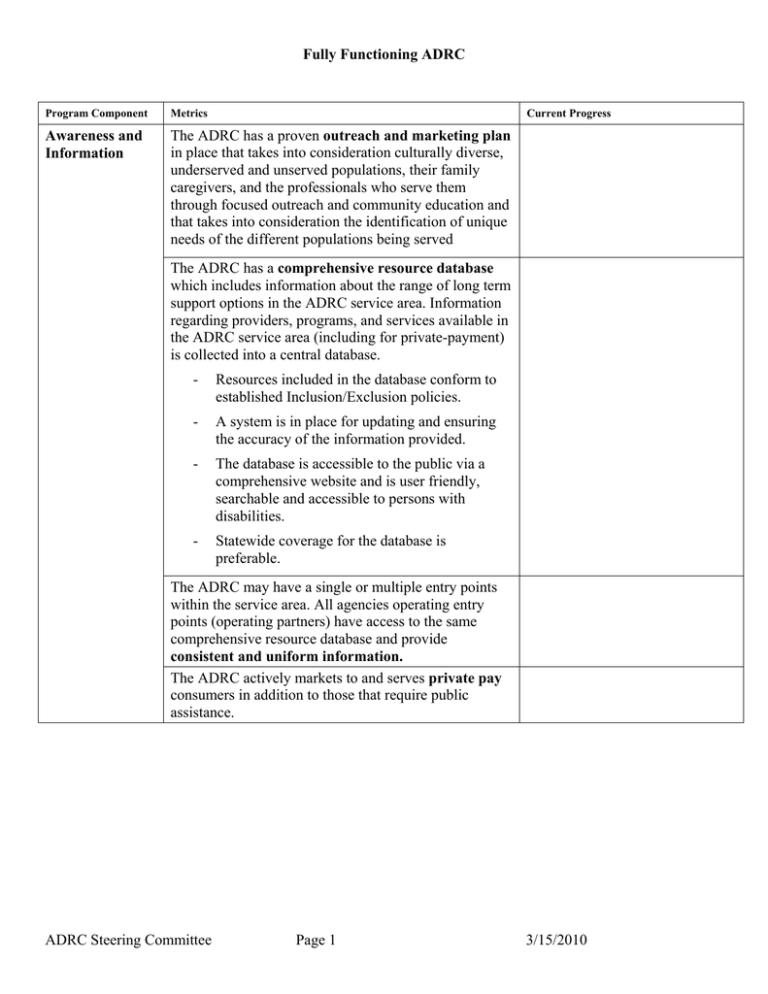
Fully Functioning ADRC Program Component Metrics Current Progress Awareness and Information The ADRC has a proven outreach and marketing plan in place that takes into consideration culturally diverse, underserved and unserved populations, their family caregivers, and the professionals who serve them through focused outreach and community education and that takes into consideration the identification of unique needs of the different populations being served The ADRC has a comprehensive resource database which includes information about the range of long term support options in the ADRC service area. Information regarding providers, programs, and services available in the ADRC service area (including for private-payment) is collected into a central database. - Resources included in the database conform to established Inclusion/Exclusion policies. - A system is in place for updating and ensuring the accuracy of the information provided. - The database is accessible to the public via a comprehensive website and is user friendly, searchable and accessible to persons with disabilities. - Statewide coverage for the database is preferable. The ADRC may have a single or multiple entry points within the service area. All agencies operating entry points (operating partners) have access to the same comprehensive resource database and provide consistent and uniform information. The ADRC actively markets to and serves private pay consumers in addition to those that require public assistance. ADRC Steering Committee Page 1 3/15/2010 Fully Functioning ADRC Program Component Metrics Current Progress Options Counseling Intake ADRC has the capability, either through a single operating organization or through close coordination among operating partners, to provide accurate and comprehensive long term support options counseling to any consumer who requests it. All ADRC entry point agencies use standard intake and screening instruments. Protocols are in place to identify consumers who will be offered options counseling. At a minimum, this will include consumer that have gone through a comprehensive assessment process. Options counseling sessions: (a) entail individualized assistance; (b) are provided in a uniform manner to all ADRC consumers with the use of protocols or standard operating procedures; and (c) are conducted by staff qualified to provide objective assistance to consumers in the process of making informed decisions, as evidenced by certification requirements and/or training/crosstraining practices. ADRC can demonstrate evidence that options counseling provided enables people to make informed, cost-effective decisions about long-term care services. ADRC Steering Committee Page 2 3/15/2010 Fully Functioning ADRC Program Component Metrics Options Counseling Intake (cont.) ADRC uses systematic processes across all entry points to provide information, referral and access to services. These services include, at a minimum: Options Counseling Referrals & Follow Up Options Counseling Crisis Intervention Options Counseling Future Long Term Support Needs Planning Current Progress - Public benefits (OAA, Medicaid, Medicare including new Medicare Modernization Act benefits, state revenue programs and others) - Employment - Health promotion/disease prevention - Transportation - Crisis/Emergency services - Services for family caregivers - Residential care including assisted living ADRC has the ability to track referrals made. ADRC consistently conducts follow-up to determine outcome of options counseling. ADRC responds to situations requiring short-term assistance to support an individual until a plan for longterm support services is in place. Short-term case management is available as needed for all target populations and provided directly by ADRC (by at least one operating partner in multiple entry point systems), or is contracted out. Evidence of one of the following: (1) ADRC is involved with Own Your Own Future Campaign; (2) ADRC is a pilot Home Equity Conversion Mortgage counseling site; or (3) ADRC provides futures planning directly or contractually by staff who possess specific skills related to LTC needs planning and financial counseling. ADRC Steering Committee Page 3 3/15/2010 Fully Functioning ADRC Program Component Metrics Current Progress Access ADRC has a single, standardized entry process for accessing public and private services. In multiple entry point systems, the entry process is coordinated and standardized so that consumers experience the same process wherever they enter the system. For ADRCs with multiple entry points, the entry processes are overseen by a coordinating entity. Financial and functional eligibility determination processes are highly coordinated. ADRC uses uniform criteria across sites to assess risk of institutional placement in order to target support to individuals at high-risk. ADRC staff conduct level of care assessments that are used for determining functional eligibility, or ADRC has a formal process in place for seamlessly referring consumers to the agency that conducts level of care assessments. ADRC staff assist consumers as needed with initial processing functions (e.g., taking applications, assisting applicants in completing the application, providing information and referrals, obtaining required documentation to complete the application, assuring that the information contained on the application form is complete, and conducting any necessary interviews. 42 CFR 435.904). Staff located on-site within the ADRC can determine financial eligibility (staff co-located from or delegated by the Single State Medicaid Agency), or ADRC staff can submit completed applications to the agency authorized to determine financial eligibility directly on behalf of consumers. ADRC is able to track individual consumers’ eligibility status throughout the process of eligibility determination and redetermination. ADRC Steering Committee Page 4 3/15/2010 Fully Functioning ADRC Program Component Metrics Current Progress Access (cont.) In localities where waiting lists for public LTC programs or services exist, there is a process by which the ADRC is informed of consumers who are on the waiting list and the ADRC conducts follow-up with those individuals. There is a process by which the ADRC is informed of consumers who are determined ineligible for public LTC programs or services and the ADRC conducts follow-up with those individuals. ADRC has a plan for reducing the average time from first contact to eligibility determination and the average time is below current time requirement. There is a reduction in the rate of institutional placement in the ADRC service area. ADRC tracks diversions and transitions (i.e., # nursing home diversions attempted and # of successful diversions; # nursing home relocations to community completed). ADRC can report the proportion of consumers requesting services that actually receive them. ADRC has a plan for streamlining access to long-term care signed by the State Medicaid Agency, State Unit on Aging and the State agency(s) representing target population(s) of people with disabilities. (Streamlining Access Plan). ADRC Steering Committee Page 5 3/15/2010 Fully Functioning ADRC Program Component Metrics Current Progress Target Populations The ADRC tracks the number of actual individuals served against the resident population estimate, by target population. ADRC demonstrates competencies relating to serving all of its target populations. ADRC is accessible to all of the populations it serves. There is evidence that the ADRC is moving towards the goal of serving all persons with disabilities, either through a single operating organization or through close coordination among operating partners. Critical Pathways to Long Term Care Support ADRC has “formal linkages” that involve all three of the following components that are updated on an ongoing basis: (1) providing training and education about the ADRC to critical pathway providers (CPPs); (2) involving CPPs in advisory board representation; and (3) establishing protocols for referrals, particularly with hospitals and LTC facilities. Partnerships & Stakeholder Involvement ADRC has an agreement with Medicaid agency to ensure that access to Medicaid benefits is as streamlined as possible for consumers; MOU describes explicit role of each agency and information sharing policies. There is evidence of collaboration, including formal agreements, at the state and pilot level between aging and disability partners. ADRC has protocols for information sharing and crosstraining across entry point operating partners and with other critical aging and disability services partners in the community. ADRC Steering Committee Page 6 3/15/2010 Fully Functioning ADRC Program Component Metrics Partnerships & Stakeholder Involvement (cont.) If the ADRC and SHIP are operated by separate entities, there is a MOU or Interagency Agreement establishing, at a minimum, a protocol for mutual referrals. IT/MIS Current Progress There is evidence of strong collaboration with programs and services instrumental to ADRC activities including home and community-based service providers, residential care alternatives including assisted living, institutional care providers, hospitals and other critical pathways and others. Formal mechanisms for consumer involvement have been established, including consumer representation on the state/local SEP/ADRC advisory board or governing committee and there is evidence that consumers have been involved in planning, implementation and evaluation activities. ADRC uses a management information system that can support the program functions. ADRC can submit evidence of reports on the following: - # of unduplicated consumers YTD - Referrals for current month, referring agency/entity, # referrals under age 60; # referrals age 60 and older. o Types of assistance provided o Timing of eligibility determinations o Information regarding level of impairment and preferred support need o Disposition/placements (e.g., waiver, institution) ADRC has established an efficient process for sharing information electronically with external entities, as needed, from intake to service delivery. In multiple entry point systems, all entry points use MIS that allows for electronic exchange of resource and client data across entry points and with other partners, as appropriate. ADRC Steering Committee Page 7 3/15/2010 Fully Functioning ADRC Program Component Metrics Current Progress Staffing and Resources ADRC has adequate capacity to assist consumers in a timely manner with long term support requests and referrals, including referrals from critical pathway providers. ADRC has an individual assigned to be the overall director/manager/coordinator of all ADRC operations. It is particularly important to have an overall coordinator or manager with sufficient authority to maintain quality processes when ADRC functions occur in more than one location or agency. ADRC has conducted an assessment of potential funding sources such as Medicaid Federal Financial Participation, foundations and community organizations. ADRC Steering Committee Page 8 3/15/2010
